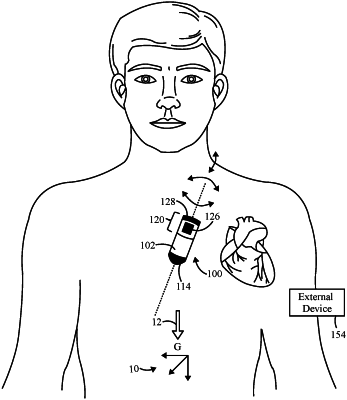| CPC A61N 1/3962 (2013.01) [A61B 5/361 (2021.01); A61N 1/3756 (2013.01); A61B 5/352 (2021.01); A61B 5/364 (2021.01); A61B 5/366 (2021.01); A61N 1/056 (2013.01); A61N 1/3622 (2013.01); A61N 1/36542 (2013.01)] | 20 Claims |

|
1. A computer implemented method for determining heart arrhythmias based on cardiac activity, comprising:
under control of one or more processors of an implantable medical device (IMD) configured with specific executable instructions,
obtaining far field cardiac activity (CA) signals at electrodes located remote from the heart, the far field cardiac activity comprising, in part, normal sinus rhythms;
determining an axis of an accelerometer associated with a current posture based on first and second calibration acceleration signatures, the first calibration acceleration signatures obtained along a first axis of the accelerometer of the IMD, the first calibration acceleration signals indicative of heart sounds generated in connection with first and second postures of a patient, the second calibration acceleration signatures
obtained along a second axis of the accelerometer of the IMD, the second calibration acceleration signals indicative of the heart sounds generated in connection with the first and second postures of a patient;
obtaining acceleration signatures along the axis of the accelerometer in connection with the analyzing the far field CA signals; and
evaluating the acceleration signatures to identify heart sound (HS) indicated ventricular events to identify under-sensed or over-sensed ventricular events (VE) in the far field CA signals.
|